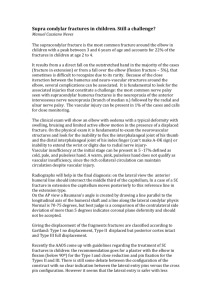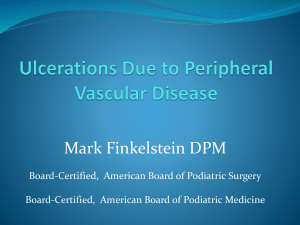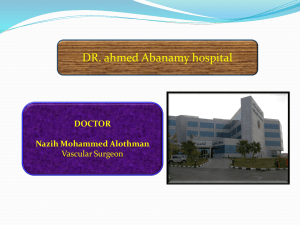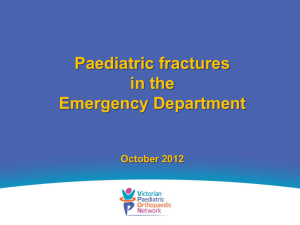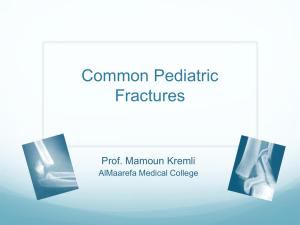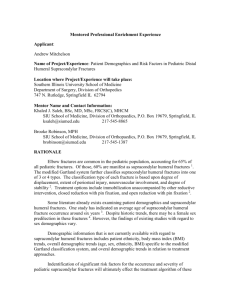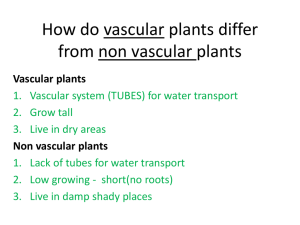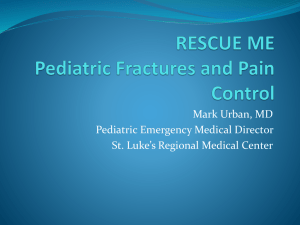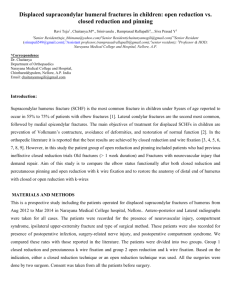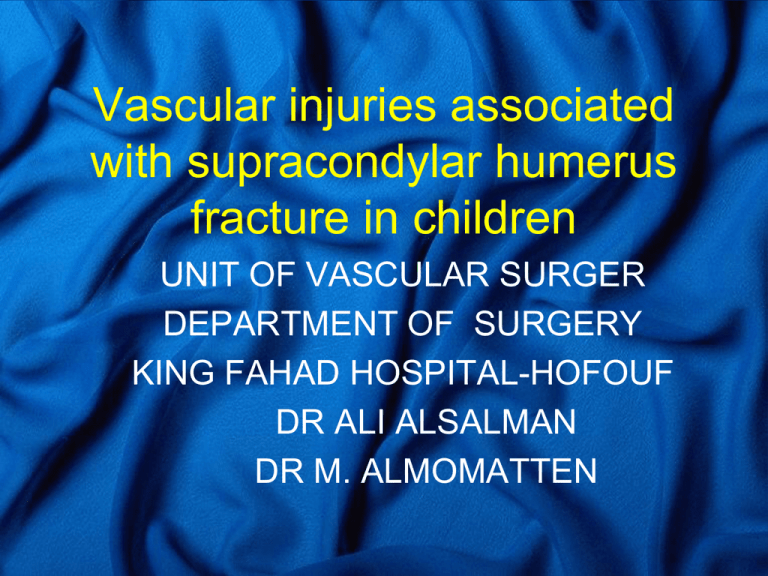
Vascular injuries associated
with supracondylar humerus
fracture in children
UNIT OF VASCULAR SURGER
DEPARTMENT OF SURGERY
KING FAHAD HOSPITAL-HOFOUF
DR ALI ALSALMAN
DR M. ALMOMATTEN
PATIENTS & METHODS
Retrospective review of pediatric patients
who were diagnosed to have vascular injury
associated with supracondyler humerus
fracture and managed at KFHH over 7
years period(Jan2005-dec 2011 )
10 patients presented with pulseless
ischemic hand following closed reduction
of supracondyler fracture of humerus.
.
Results
• 10 PTS were included n the study
• MEAN AGE : 7 (3—11YRS)
• SEX: MAINLY MALE PTS( M:F 6 : 4 )
TIME OF PRESENTATION
MAJORITY OF THE PATIENTS
PRESENTED WITH LESS
THAN 6 HOURS .
DIAGOSTIC MODALITIES
CLINICAL ASSESMENT
HAND HELD DOPPLER
DUPLEX SCAN
RESULTS
10 cases presented with ischemic
pulseless hands following supracondylar
fracture of humerus .
surgical exploration of cubital fossa done
in 8 patients who continued to have
pulseless ischemic hand after # reduction.
RESULTS
on exploration of the cubital fossa the
brachial artery was found trapped at the
fracture site which was released in all
of the 8 cases .
5 patients had theire pulses returned
back shortly after the release .
brachial artery was found crushed and
thrombosed in 3 patients which all were
repaired by interpositional vein graft using
ipsilateral basilic vein .
RESULTS
one patient presented with
pulseless ischemic hand
and open fracture distal
humerus where immediate
exploration and repair of the
transected brachial artery
using a basilc vein .
RESULTS
one patient had close reduction
and fixation however the hand
still pulseless but warm and well
perfused therefore patient was
managed conservatively and the
pulse regained after few hours .
RESULTS
• -Associated
nerve injury
• MEDIAN(2pts) & ULNAR(1pt) NERVE
INVOLMENT WERE
NEUROPREXIA ONLY WITH
COMPLETE RECOVERY WITHIN 3
MONTHS
RESULTS
EPSILATERAL BASILIC VEIN WAS USED
IN ALL CASES REQUIED ARTERIAL
REPAIR
OUTCOME
-followup 12month(average)
LIMB SALVAGE RATE :
100 %
MORTALITY RATE
: ZERO
ALL PTS HAD NORMAL,SYMETRICAL
CIRCULATORY&NEUROLOGICAL
FUNCTIONS OF THE UPPER LIMBS
DISCUSION
-Supracondyler # of humerus is a common
trauma in children, associated with 4-12%
of brachial artery injury,
-Echemosis in the cubital fossa,botton
holdin of brachialis muscle, postero-lateral
displacement of the the fracture (x-ray)
indicate potential neurovascular injury
-Careful clinical assessment, non-invasive
vascular studies:most valuable tools to
assess vascular insuffciency in these
cases
Vascular involvement
(10-15% with type III
Present with absent
pulse)
• Medial
displacement of
the distal
fragment places
the radial nerve
at risk
• Lateral
displacement of
the distal
fragment places
the median nerve
and brachial
artery at risk.
Operative Management
Systemic heparinization
Debride injured vessels to macroscopically
normal arterial wall
Remove any intraluminal thrombus with
Fogarty catheters (proximal and distal to the
arterial injury)
Flush with heparinized saline solution:
proximal and distal arterial lumina
No tension arterial repair, interupted sutures
using 7.0 prelene
Interposition
autogenous vein graft
• Arterial reconstruction using the basilic vein from
the zone of injury in pediatric supracondylar
humeral fractures: a clinical and radiological
series.
• Lewis HG, Morrison CM, Kennedy PT, Herbert KJ
• The authors describe the advantages of using the basilic vein as an arterial
conduit in the management of children with supracondylar humeral fractures
requiring vascular repair.
This series confirms the safety of
using a donor vein from within the zone of injury for
arterial reconstruction, after a supracondylar humeral
fracture. Benefits include a single surgical wound on
the less conspicuous medial side of the arm, reduced operating time, and
preservation of donor veins that may be subsequently required for the
management of atherosclerotic disease.
• PMID:
• 12621186
• [PubMed - indexed for MEDLINE]
• The pink pulseless hand: a review of the literature regarding
management of vascular complications of supracondylar humeral
fractures in children.
• Griffin KJ, Walsh SR, Markar S, Tang TY, Boyle JR, Hayes PD.
• Abstract
• Supracondylar fractures of the humerus are the commonest upper limb
fractures in children, accounting for up to 70% of all paediatric elbow
fractures.] and are often complicated by neurovascular injury. Much
confusion surrounds the management of the child with a "pink pulseless
hand" post-fracture reduction and several treatment options have been
proposed including observation, immediate exploration and angiography.
The literature contains a number of case series with variable follow-up. A
child with a pink pulseless hand post-fracture
reduction can be managed expectantly unless
additional signs of vascular compromise develop, in
which case exploration should be undertaken.
• PMID:
• 18851922
• [PubMed - indexed for MEDLINE]
CONCLUSION
• Carefull clinical assessement with high
idex of suspecion remains the most
valuable tool for early detection&
intervention of vascular injury associated
with these fractures in order to prevent
ischemic complications

